-
Posts
45 -
Joined
-
Last visited
Content Type
Profiles
Forums
Store
Help Articles
Posts posted by ThePieman
-
-
Well folks, its been a looong time since an update, I am still no further ahead and dropped the ball for a while, having moved from Germany to Shanghai. I woke up this morning wondering where had I got to with this search, Its taken me some hours to read through everything again, however in doing so I came across an Indonesian reference to Chicken Rissoles where the cook dipped the roll into beaten egg and then dropped that into the fat: no flour, no breadcrumbs... I thought that was interesting. On reflection I feel now that a lecithin emulsion is not the way to go, given the quality issues such as oil seepage, and dough tensile strength. So back to the drawing board.
-
Just toughing down... fried puff pastry? Not right, but promising. Same old, same old... textural issues. Rissoles were nice but.
-
Hi folks, I appreciate your interest in this topic and my faltering steps in trying to understand it all. I also appreciate your input and comments. Through this dialogue I've been able to ask the right questions and find, what I think is, the right information needed to help unravel this dilemma (...all my problems have become dilemmas.)
I'm currently in limbo with internet access so this'll be a quick one, but it has afforded me the chance to re-quiz my older books and I believe I've now identified the underlying cultural traditions that led to and informed the development of the Chiko Roll. Based on the evidence at hand, I can now say that there is a very long tradition of fried pastry dough in Australian cuisine, but by the time I was a lad, it was fast falling out of favour with home cooks.
Thank you, one and all, for your assistance. I think this thread is probably at its natural closing point. So, I invite you to read all about it, the cultural traditions underpinning the development of the Australian Chiko Roll on my blog. When I develop the recipe further and complete a few more experiments, I'll post a new update and share the recipe. Cheers.
"Veal Rissoles," from Australia's first published cookbook, 1864.
-
Images:
1: Preparing to sheet a 15cm by 40 cm sheet of dough using kitchen wrap. The resultant sheet should be about 3-4mm thick.
2: Closeup of the texture, colour and appearance of the flash fried roll.
3: Autopsy shot to examine the thickness and doneness of the dough casing (filling not important, but being tasty is...)
This image also shows that the roll indeed collapsed under its own weight and flattened out rather than maintain a more cylindrical appearance.
-
Ok, what follows is the culmination of my endeavours thus far. There are still problems, so any thoughts or clarifications you can offer would be most welcome.
Egg Batter Dough (Well… emulsified oil with lecithin dough, commercial Chiko Roll pastry dough)
AP Flour 100%, Wheat Cereal (Semolina) 16%, Lecithin 2%, Salt 1.5% – Water 52%, Sunflower Oil 16%
Method
Wheat Cereal and Water was combined in a 1:2 ratio and set aside for 30 min. to soak and soften. Salt and Lecithin were added to the remaining water and mixed with a stick blender. To this the Oil was drizzled in and blended into an emulsion. To the emulsion was then combined with the flour to form a moderately firm dough (approx. 58% moisture content), after which the dough was set aside in the refrigerator for an hour to rest. The dough was then flattened out into a sheet, filled rolled up and deep fried for 20-30 seconds at around smoking point for the oil (approx. 440F/226°C). The roll was then visually evaluated for texture, strength and colour.
Results
Colour – pale biscuit
Texture – crazed, rough, small blisters
Strength – relatively stable, can be held in the hand, but lacked some crushing/holding resistance
Discussion
This dough, is still too soft, it doesn't stick to the bench or hands, but does leave an oily patch where ever it lays long enough. It has less moisture content than an egg pasta dough (3:2) but none of the structural strength properties. Unlike very short crust pie doughs (3:2:1), this emulsified oil (mayonaise) based dough is very, very soft and exhibits none of the structural characteristics. due to these issues, it is easy to roll out but hard to handle and work with as it does not retain a tube like shape after forming into a tube but collapses under its own weight.
So far for the objective stuff, now for the conjectural side.
I could certainly knead more flour into the dough; I have half of it left, weighing before and after thus knowing what I started with and finished adding to it( I wonder, that might work… note to self, do this.)I don't understand why this dough is so soft. Is it the lecithin? Is it the oil? Is it the water? Is it the flour? All of, or none of, the above? Is it my method? Is it the ingredient ratios? I just don't know. If I add more flour and reduce the water content, will I still get the same textural response on frying the dough? These are the questions I'm wrestling with.
Insights? Anyone?
[Addendum: it appears that the oil is not emulsified into the dough as it weeps out after a period of time...]
-
Interesting Wikipedia entry. Prompted me to look further afield and found this, History of Pasta.
-
Oh, and an Italian connection, of sorts: Fried lasagna rolls, never heard of them before - fried pasta… who woulda thunkit?
-
Ah Serendipity, don't you just love those little gifts of good fortune, realised after a mistake, that come every now and then? So today's report. Cooked semolina? Its a no go. Makes the dough too soft and the control of moisture content goes out the window. On top of this the subsequent dough when cooked? Nice as it is, is not the right texture, doughiness, yeah, the mouthfeel is all wrong.
I think the next option is to just soak the semolina in water and add it to the dough mixture and stiffen the dough with more flour. I am now, more than ever convinced that it is simply a pasta dough with semolina added and then deep fried.
Now, the serendipity bit. normally I fry these things at 180-190°C. Today I put the oil on, and then turned the heat down (lid on of course, by the time I got back to it, it was smoking hot, not livid, but smoking al the same. When I dropped the dough (wrapped around a beef sausage – the filling is not the issue here) very quickly it began to blister and texture in just the way I wanted.
The answer to that question then? The texture is an artefact of deep frying. I now believe that the rolls after assembly are flash fried for (edit: 20-30 sec.) pale biscuit, i.e. not browned; in very hot oil to set the texture (commercially) then flash frozen for finishing off and colouring, at normal oil temperatures, in the chippie, on demand.
I feel that the semolina is added to increase the surface area of the pastry dough and enhance the texture. Flash frying will texturise the surface along micro sites, but longer frying will cause significant blistering.
I got some videos to edit, but I DO feel this is a significant move forward… I might of actually cracked it: la la la la la... … Just kidding.
Technique-wise, the take home info from today's experiment is: a soft, pasta-like dough, wrapped around a filling, when deep-fried in very hot oil will blister and texturise on the surface.
When I get the videos done, I'll append a link. Cheers! Its been an interesting and otherwise fruitful day.
-
 1
1
-
-
On 11/2/2016 at 2:01 AM, JeanneCake said:
So I was browsing the Chef Rubber site today and …
Interesting reference, so I looked it up. Its available via Modernist Pantry.
http://www.modernistpantry.com/crisp-coat-uc.html
On 11/2/2016 at 2:38 AM, Kerry Beal said:I think that Crisp-Coat is the same as Trisol - makes for a lovely tempura that is wonderfully crispy and remains so when it cools - but I suspect it wouldn't give the texture that he is after in this application.
When I read that it needs to be kept in motion to keep it in solution I immediately thought of corn starch. It turns out that its a modified corn starch. Yes it would give a crisper texture, like tempura.
Which begs the question, Is the texture I'm looking for, a function of the dough's reaction to being immersed into hot oil? OR, is the texture built in, as part of the ingredients used to manufacture the dough?
Originally, the dough was supposed to be an, "egg batter dough." What does that even mean? (In a 1950's Australian context?) I can't find any contemporary references to such a dough. 1940's-50's Australia (Victoria) was predominately Australian/British cookery with ethnic cuisine inroads from Chinese/Cantonese (goldfields), Greek, Italian, & post-War European migration.
The roll was developed in direct response to Chinese Spring Rolls, which in Australia, grew or bloated into a similar sized 20cm long roll. Did this occur before the development of the Chiko Roll or in response to its popularity? I don't know and I'm not sure we'll ever know. What I do know is that the Chiko Roll and the Spring Roll are two very different beasts that share a similarity in shape only. The texture of a deep fried Spring Roll wrapper is very different to that of a Chiko Roll casing.
I cannot find anything remotely like it. The modern, commercial version is a savoury, deep fried, unbreaded, dough that exhibits sand-like, surface textural features that look like tiny explosions/ruptures, that casually resembles breadcrumbs or polenta/semolina.
We have French, British, possibly Italian, & Greek/Mediterranean culinary traditions to draw upon. I have looked at hot water pie dough, soda bread dough, pancake batter turned into dough, pasta dough, and variations on each of these themes. I have looked at rolling the dough in grits, in breadcrumbs, etc. The problem I feel is that I guess I've not had a systematic plan for approaching this challenge.
In other words, until now, I've not articulated clearly the either or question above and how the target cuisines might inform answering that question. How's that for clarity? Thanks folks. btw., experimenting with making a egg batter past dough using soaked/cooked semolina as an ingredient. Will let you know how that turns out, in order to bring previous endeavours to a close.
-
An interesting aside: deep fried Semolina… seems to be popular in Indian cuisine, here's a fusion recipe,
the reason I present this is that I find the technique and texture interesting, however a batter would not be applicable to my application. Be that as it may, and having looked at the Brazilian mix, choux pastry, and polenta pastry, I think there is a convergence of ideas. Not yet sure where, but, still looking. My main Cooking references are dated, (AU)1934, (NZ)1938 and (AU)194-? so, these books are in the historical reference region that would be common knowledge for the inventor of this "egg batter dough." Its hard to accept that the guy came up with a novel, new, and previously unknown method of making essentially, deep fried pastry dough.Yet, there seems to be no historical record of anything that remotely resembles it – feels like I'm banging my head against a wall. It sure does feel good when I momentarily stop though…
-
 3
3
-
-
7 hours ago, Franci said:
...Have you tried dough used for ... coxihnas?
I really have to say thank you for your comment, its given me lots to look at and turned my attention towards Italian/Greek/Turkish – Semolina/Polenta pastry. I never knew such pastry existed! Don't you just love the diversity in our culinary world? So happy!

-
6 hours ago, Franci said:
Just a thought. Have you tried dough used for Brazilian rissoles or coxihnas? No egg in there and the dough is previously cooked like a panade.
I've not heard of this type of dough, what is it? Got a recipe?
 4 hours ago, Kerry Beal said:
4 hours ago, Kerry Beal said:Interesting idea - cooking the semolina in with it might leave the texture but avoid the issue of sandy bumps.
interesting point, I'm gonna have to look at this further. I'm also trying to work from a 1950's Australian context as well, so I'm not sure if this method may have been familiar to the creator of the roll, although it seems he was reasonably informed about Greek and Italian, as well as trad. Brit/Australian cooking.
Is there a parallel that you're aware of that I ought to be exploring?
-
This thread has been a hoot! Love the word, "sous-videiness." Honestly, I feel for the OP. Hype marketing can be really frustrating, especially if you happen to cook better than many of the restaurants you tend to visit.
Sous Vide is an old technique, a commercial processing technique and has only recently come into Cheffy fashion. I daresay much of the main meals you eat on airplanes have been prepped sous vide. The upside of the cheffy interest is that the GP get to say, hey I wanna do that too, and all sorts of new kitchen toys come to the home dining room table.
The only thing I really found provocative was the initial, "boil in the bag" reference but that was expertly handled by other posters. For me, there is a texture imparted to the final product that is characteristically, an element of sous-videiness. This is most noticeable in fish and, eggs, which many don't particularly like (texture, that is.) Many tenderer cuts of meat are also susceptible to over tenderising from being too long in the bath. Visually, I look for the tell-tale edge to edge uniform doneness of the meat, and lack of greyness around the edges for an indication of well applied technique.
If something is meant to be tender, it should be tender, but not mushy. If its normally tough as boot-leather yet comes to the table fork tender with the taste and aroma still intact, and not like a piece of cardboard, then that is really treat-worthy. I'd recommend for the OP to experiment with the method, to get a greater hands on feel for the technique, so that they are better placed to appreciate a masterpiece, as well as identify roadkill.
Lastly, pigs bladders and vacuum. (You don't always need a machine to apply a vacuum, there are other ways.) I do believe someone may have tried (been tried for?) that in the past, but very quickly discovered the unintended consequences of applying a vacuum to any sort of badder.
 Cheers.
Cheers.
-
Latest Update.
Emulsifying the Fat:
Ok, so I mentioned, emulsifying the fat with either lecithin or egg yolk. Well, I prefer the lecithin method over egg yolk.Both make robust doughs, but the egg yolk dough is, more tender, softer, if you will, and moister (translate as gummy on the inside) which impacts cooking time and doneness.
Wheat Cereal and Texture:
I had previously tried to coat the roll in a light coating of Semolina (wheat cereal, auf Deutsch - Grieß) but the result was sandy rather than craggy and rough. So I thought lightly pressing the cereal into the dough and then covering ith a moist towel might help the cereal to soften and swell with the moisture. It did somewhat, but not enough. I also thought that with swelling, it was more likely to 'pop' when fried. With two trials, one, lightly dusted and the other actually pressed into the dough, I've found I liked the result better when pressed into the dough.
This leads me to consider, that the wheat cereal is perhaps an actual component of the dough, i.e is is part of the mixture. This would also result in the semolina swelling and perhaps cause the resultant surface texture, as well as lend a bit more toothiness to the final cooked dough. I still have to try this.
Clagginess/Doneness:
Lastly, I've been using quite soft, moist doughs and feel this may be causing some of the problems with overall doneness of the final cooked dough. The original product is indeed, partially gummy when done, but not to the extent that my doughs have been. So here's the question? How does dough wetness impact the frying characteristics of a dough?
Addendum, Images:
Image 1 (img_9659.jpg) shows the dough covered with semolina and placed under a moist towel, the second one not yet covered. In the bowl is a paste of egg white and semolina (a bit too thick).
Image 2 (IMG_9662.jpg) shows the filling I'm using to fill the rolls. Honest to goodness meat and veg, no junk food here.
Image 3 (IMG_9667,jpg) shows the roll being fried. I used a tamale press, for convenience, this time round rather than the pasta roller. I think in the future, I'll stick with the pasta roller, it makes the ends and seams neater and easier to work with.
-
 3
3
-
-
On 10/11/2016 at 11:02 AM, Lisa Shock said:
BTW... I use egg wash prior to filling pies and baking them.
Before blind baking, or before normal filling and baking?
-
20 hours ago, EvergreenDan said:
...I wonder what the bitter version of the cocktail was.
Me too.
20 hours ago, tanstaafl2 said:...also sounds like it would be a challenge to ever know what the original cocktail tasted like.
yeah, 30 something years ago I was just completing high school, and its a real challenge for me just to remember what the local hamburger tasted like. I ate plenty of them, but never drank a Lufthansa Cocktail. Had I been old enough and able to enough to fly Lufthansa, it would've only been a once off affair, so I can understand the nostalgia would definitely get in the way, unless of course it was truly exceptional. So exceptional, they felt the need to change it, twice.

Recipe now in the Recipe collection.
-
This recipe is inspired by the Original Lufthansa Cocktail, not the present day commercially available version, and should end up around 30% abv. For a full history about this recipe and the original that inspired it, please visit my blog, Villa Tempest.
Ingredients:
250ml Rosé Vermouth
370 ml Apricot Schnapps/Brandy
75 ml Framboise/Raspberry Eau de vie
20 ml Orange Bitters
55 ml Elderflower Syrup
Method:
Combine all the ingredients, mix well and bottle.
Makes 1 x 750ml batch.
Serving Suggestion:
To 2 full measures of Liqueur add an equal portion of well chilled Sekt or Champagne.
Serve in a tumbler over ice, or in a saucer rimmed with a lemon segment and dipped in sugar.
Garnish with a slice of lemon, or a cherry.
-
Hi folks,
I searched here for mention, but didn't pull anything along these lines. So I want to ask, should/could7would/can I post my recipe variation of the Lufthansa Cocktail here?
I discuss its history on my blog, and the rationale behind my recipe for it, but I would love if anyone remembers the original, and is a keen mixologist, would be willing to weigh in on whether its a hit or miss.
The other reason I think it shuld be in EGullet's recipe archive is, as far as my father-in-law says, there is a recipe out there but its selling for 150€ or so. Which, I think is having a bit of a lend, if you ask me.
So, does it belong here and is it worth discussing?
-
 1
1
-
-
Correct. I'm sorry if I let that question pass, perhaps I should have addressed it.
What are YOUR favourite 3-4 home-grown fast foods? What do you miss when you travel, extensively, even if it is cross-country or interstate?
In China & Vietnam, I missed meat pies, chiko rolls, & dim sims, but most of all, Cheese. So, in China I developed a method of making fresh cheese from UHT milk. In Vietnam, I started a made-to-order Pies, Pasties, Sausage Rolls business and added a Weekend Farmer's Market Grill Station where I developed a Vietnamese variation of the Philly Cheesesteak sandwich, using all local ingredients sourced from the Farmer's Market. Every time I go back to Australia, a Four'n Twenty meat pie, a chiko roll, and a couple of steamed dim sims are always on the lunch menu in the first couple of days.
So, why reverse engineer these commercial nightmares? Because they are a deep and integral element of my childhood. They are the comfort foods that remind me of home, happiness and all that was good in the world. Can I make better quality versions? Absolutely. But, understanding the fundamental elements of the pastries that go into making these items… and the pastry is absolutely integral to the memory of these items: the tactile feel in the hand, against the tongue, resistance to the teeth, and all the rest. The filling is not as important, although it does present its own interesting challenges, as well as tangents into molecular gastronomy, regarding emulsions & thickeners, etc.
Lastly consider, why do people bother to try and recreate the "Original" Kentucky Fried Secret 11 spices and herbs? Why do people want to know how to make Chinese hand pulled noodles? Why to people want to recreated authentic Peking Duck, Tandoori bbq, Nan Bread... (the list is long.) For me? The point is in the challenge, in making it right, and to the standard as I remember it, to say, ahhh! that's it!
So, this is the foundation, from which the stepping stones to something more personal and possibly better starts.
-
 3
3
-
-
6 hours ago, JeanneCake said:
(are these fully cooked when you get them and you're just heating them through...
No. They are either quick baked or deep fat fryer blanched partially, then flash frozen and packaged. They are then meant to be finished on site and on demand.
Tried bread, raw bread dough does not produce the surface texture when fried and doesn't have the denseness on the inside. pre-baked bread sheets have a similar issue. It does have a bread-like external temperature, I'll give you that, but the cross section is all pastry dough (of some sort)

-
The single biggest issue bothering me with this, "dough" is its external texture. Have you seen my video autopsy of the product? It shows the texture very, very clearly.
My latest insight, is this. If after various methods of making dough does not produce a physical texturisation of the outside surface of the dough when immersed in hot fat, then the texture, logically, is developed in some other way. I postulate the following: After making the dough, it is dampened, then rolled in wheat cereal (semolina) and shaken off. This is then misted and held moist for an hour, which would result in the semolina swelling. Drop this moist surfaced product into hot oil and explosive steam texturisation, along with the soggy semolina getting cooked in place, might just result in the texture I'm trying to reproduce?
That's where I'm headed next. Thanks for all of your insights.
-
4 hours ago, Amymegan said:
And this is an interesting link:https://www.google.com/amp/s/mylastbite.wordpress.com/2009/05/14/trisol/amp/?client=safari
rather interesting medium, thanks for the link.
5 hours ago, Lisa Shock said:Have you ever made egg rolls?
Yes. And Spring Rolls, and Vietnamese Spring Rolls, and the fresh ones (nem) also. no bearing on this though. This is not an Asian copy, but something else that came about because of Asian Spring Rolls being too dainty and delicate in 1950's Australia, i.e. not substantial and robust enough.
That being said, similar issues apply to managing steam buildup inside the roll. That's why I suggested the thin side caps may function as a steam release mechanism.
Now, lecithin used to emulsify the fat that goes into the dough, will also impact the dough characteristics, toothiness etc., as you mentioned. So, add it to the flour, or to the fat and water? Choices.
Tumeric is not an ingredient. I used as a coulorant substitute = failure. No Problem.
-
1 hour ago, Lisa Shock said:
Here in the US, we have several TV shows that go inside factories and show various consumer goods and foods being produced.
Good suggestions, Lisa. I have tried to find some videos, indeed I did find one about Simplot Australia, but unfortunately it was rather cautious about showing various product under manufacture, and was no help in this case.
In what proportion is the Lecithin used in pastry doughs? That would be a useful ratio for determining a rough percentage of it in this product.
In the meantime here are a few pics from the last few days efforts:
Theme & Variations in basic egg batter dough.
Simple samples for frying
Nice dough, but the wrong texture. splits occurred due to sitting on a rack prior to frying.
Lecithin In dough. Today's Effort.
The setup. Pasta dough sheeter for rolling dough 15cm wide. Substituted tumeric and sweet paprica for the food coloring. Too yellow! Did lend a nice Indian-esque taste to the pastry though.
Surface response to frying. Still not right.
The seam here tended to pull apart as the tube and contents heated up. It occurs to me that the painted end serve a very particular purpose. I've always wondered why they always seemed a little broken open? Perhaps they're acting as pressure relief vales to stop the seam from splitting?
This time I decided to knock up some savoury filling to snack on along the way. Note the variation in doneness of the dough.
The dough was double rolled resulting an an inner and outer layer, which on one roll split completely. However, it is starting to lookp romising as to how the real product's dough has a similar variation in doneness.
Notes: Pastry outer was crisp and as you would expect from a really short dough that's been fried, thus is not like the original. The surface of the original appears, now, to not have been produced as an effect of frying: there are too many crags to the surface to be accountable to just blister formation.
Tumeric is not a substitute for synthetic food coloring, plus I feel it quite a lot effective, too effective in this case. In future efforts, I'll leave the coloring out completely.
The tubes need to have the ends painted rather than crimped closed as steam inside the tube tends to work against the sealing of the seam.
Have to try this again, with a thicker dough sheet, and also substituting egg yolk for lecithin. But how to get the texture?
-
I hear you but I think you might be putting the cart before the horse, so to speak. This product is 20cm long and roughly 4-5 cm in diameter, so extrusion effects may impact dough characteristics, but this is not an extruded product its rolled, cut and possibly manually finished. Since the seaming of the dough is straight and not spiralled, I do not think that the product is rolled in a single industrial length and then cut, I believe it is cut to length and then folded/rolled.
Be that as it may, industrial commercial processes being forever interesting for the curious; this product started on a home kitchen bench, and then was scaled up for manual production long before it ever became an industrially machined product. This means that the recipe would have also been modified to meet the demands and rigours of industrial processing. Hence it is no longer an "egg batter dough." Believe it or not, the minutae of this process keeps me tossing and turning all night. Last night more so than usual. Lecithin...
Here are my thoughts. (..and we touch on Molec. Gast. here, woo hoo!
 ) Lecithin is an emulsifying agent, that helps to keep oil suspended in water. When we make shortcrust pastry, we use flour to coat the fat to help suspend it in the flour water dough and keep it in place. If we take this to be a type of deep fried pie dough, a very short dough, then I posit that oil water and lecithin are blended to make a stable emulsion, seasoned flour is then added to the emulsion to form a soft dough, the dough is processed in the normal manner.
) Lecithin is an emulsifying agent, that helps to keep oil suspended in water. When we make shortcrust pastry, we use flour to coat the fat to help suspend it in the flour water dough and keep it in place. If we take this to be a type of deep fried pie dough, a very short dough, then I posit that oil water and lecithin are blended to make a stable emulsion, seasoned flour is then added to the emulsion to form a soft dough, the dough is processed in the normal manner.
If we take this idea back to the home kitchen to explore processes it might replace, the only thing I can think of is using egg yolk to form a mayonaise with the animal fat, thinning that with water to enable a smooth batter to be formed and then thickening that into a soft, pliable dough. I have both lecithin and eggs, so my next step is to see what comes of that. Thanks to one and all for being great sounding boards and helping me to focus better on this topic. I would never have even considered the Chiko Roll to a deep fried tubular "pie," not of emulsifying the fat before making the dough.





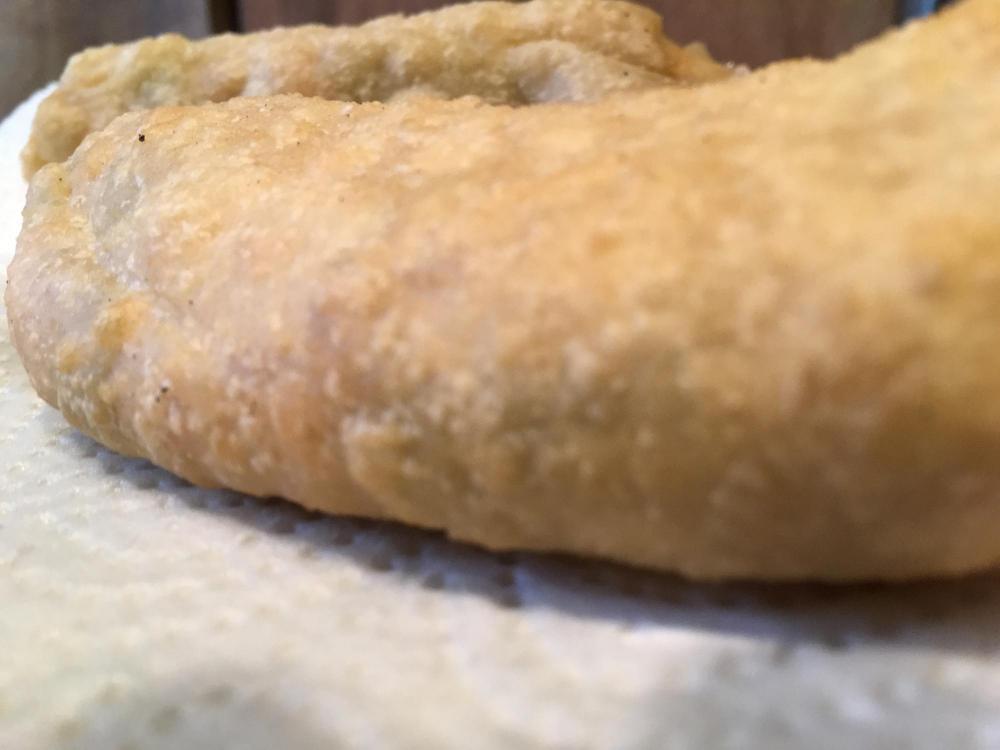

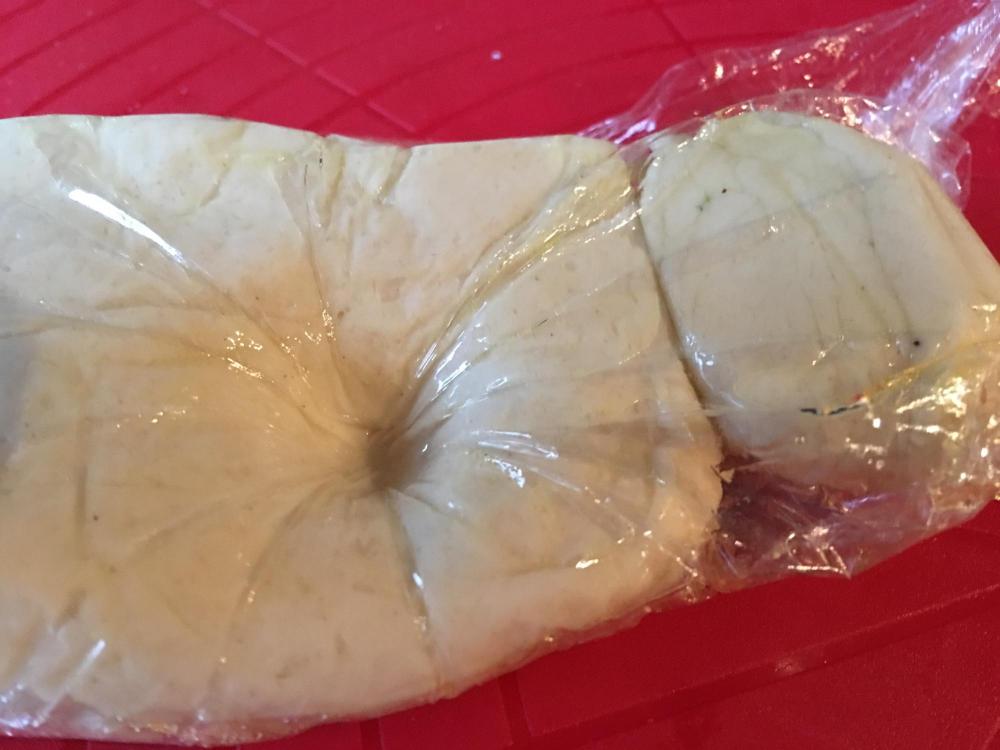

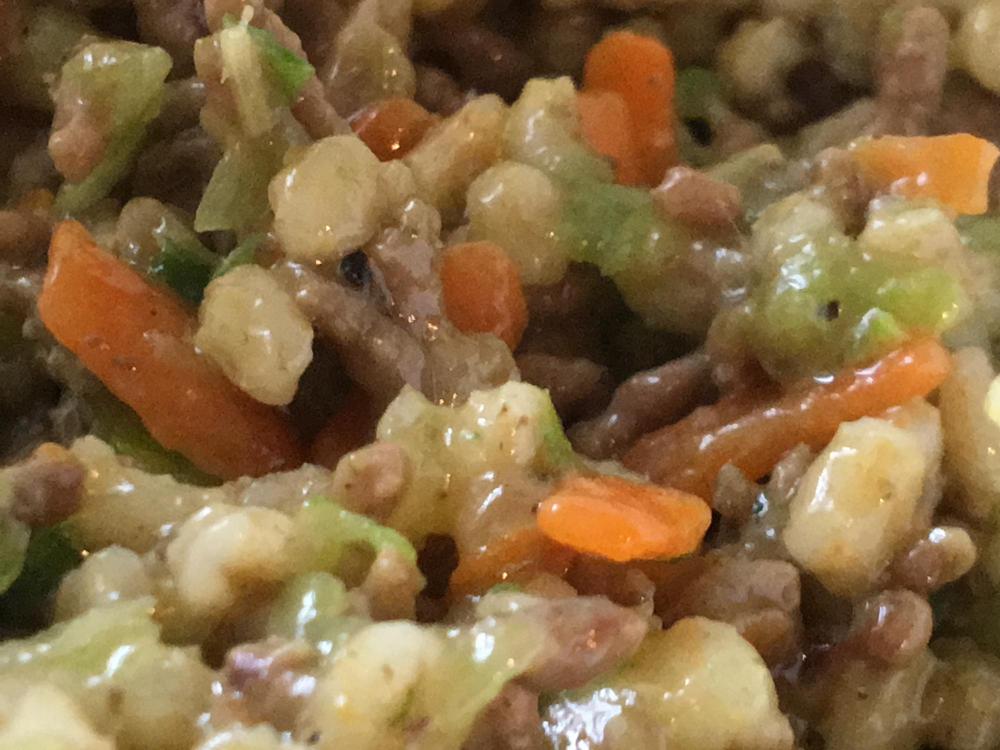

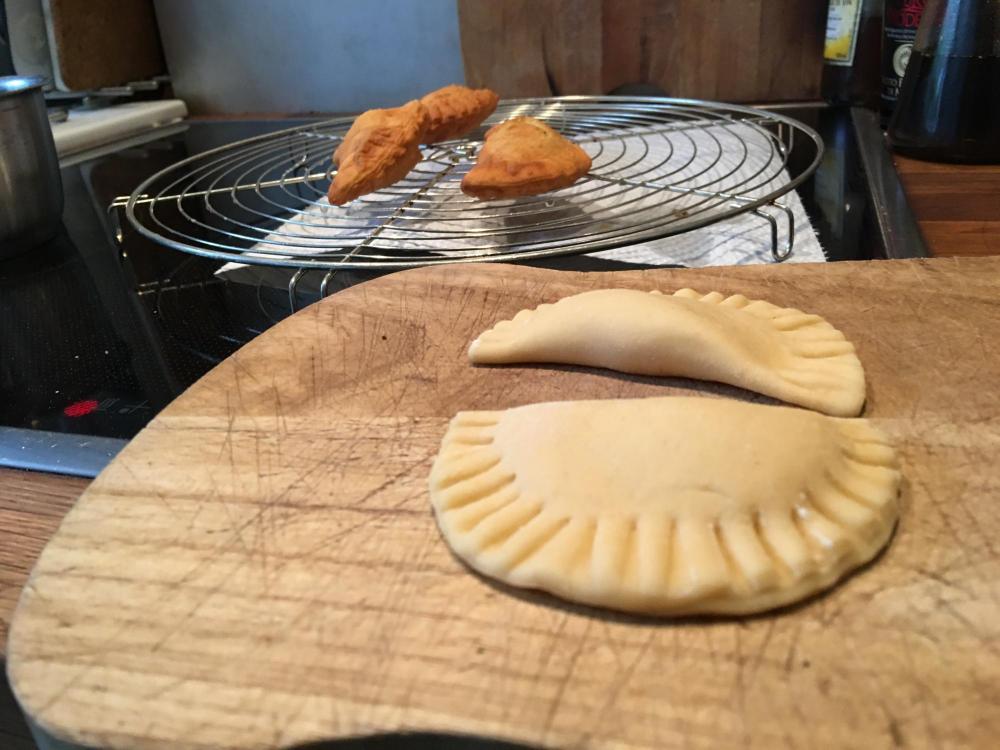

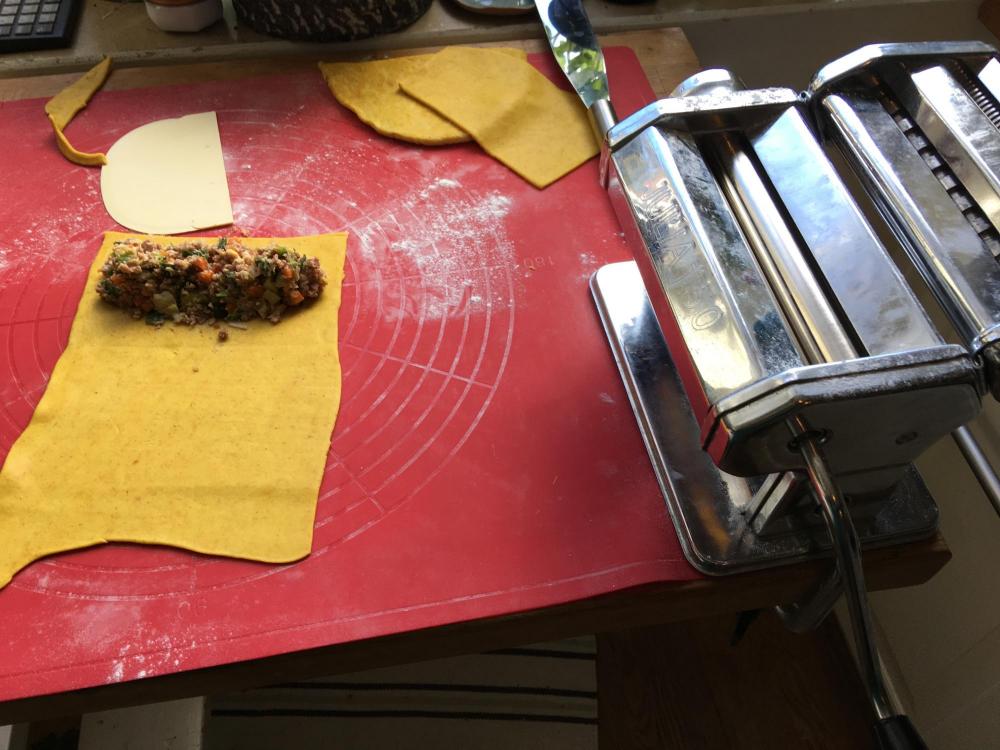
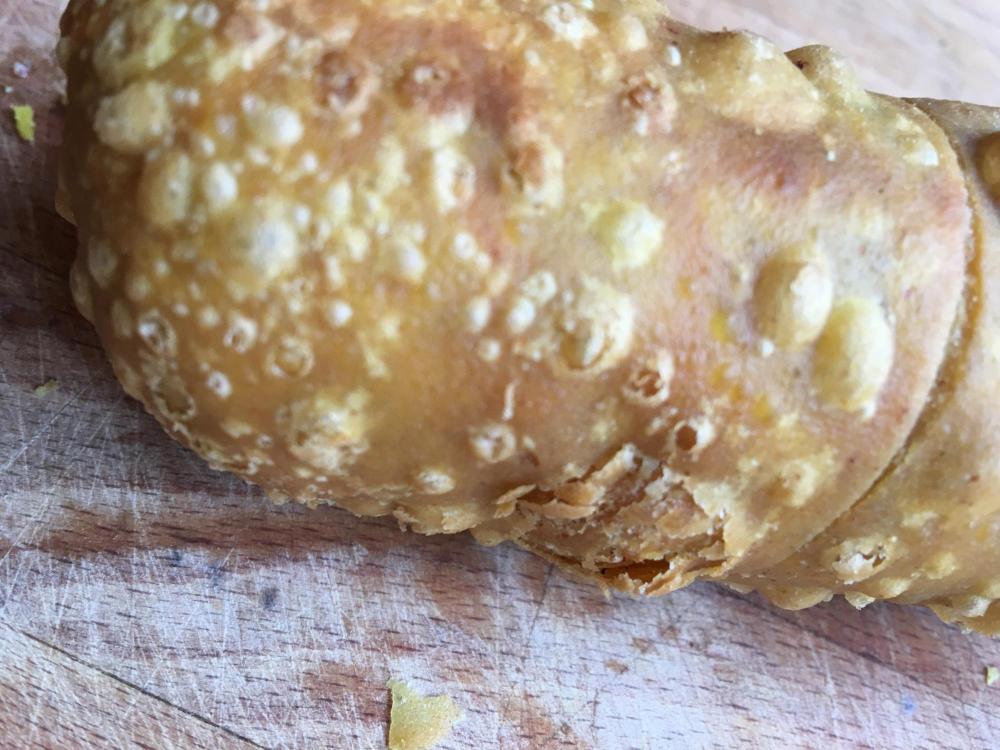
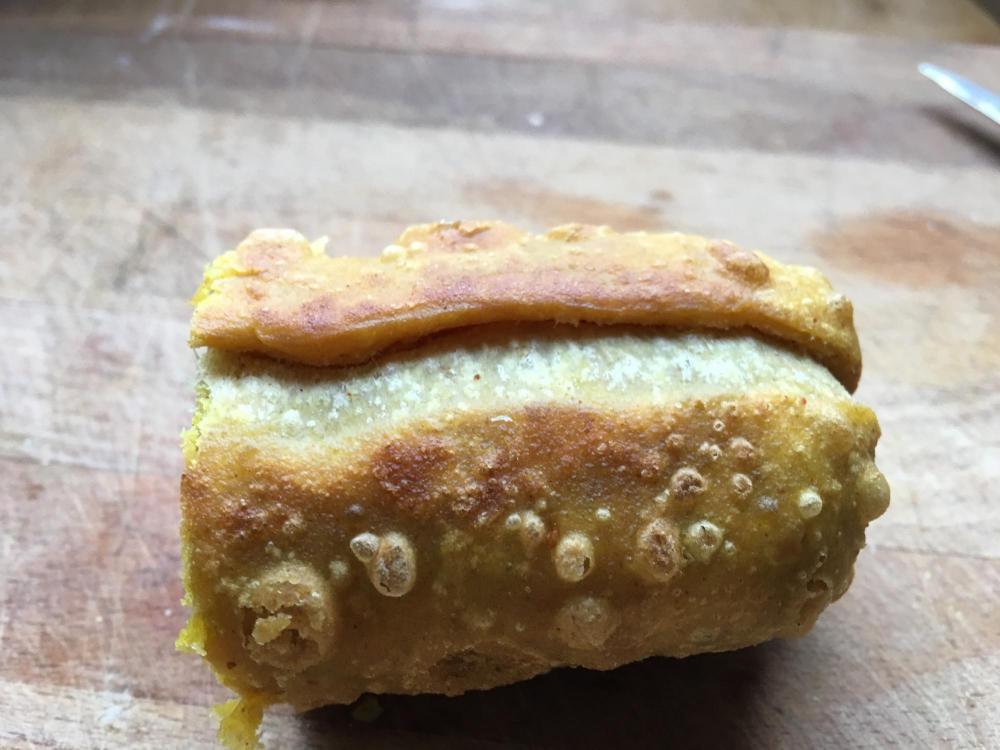
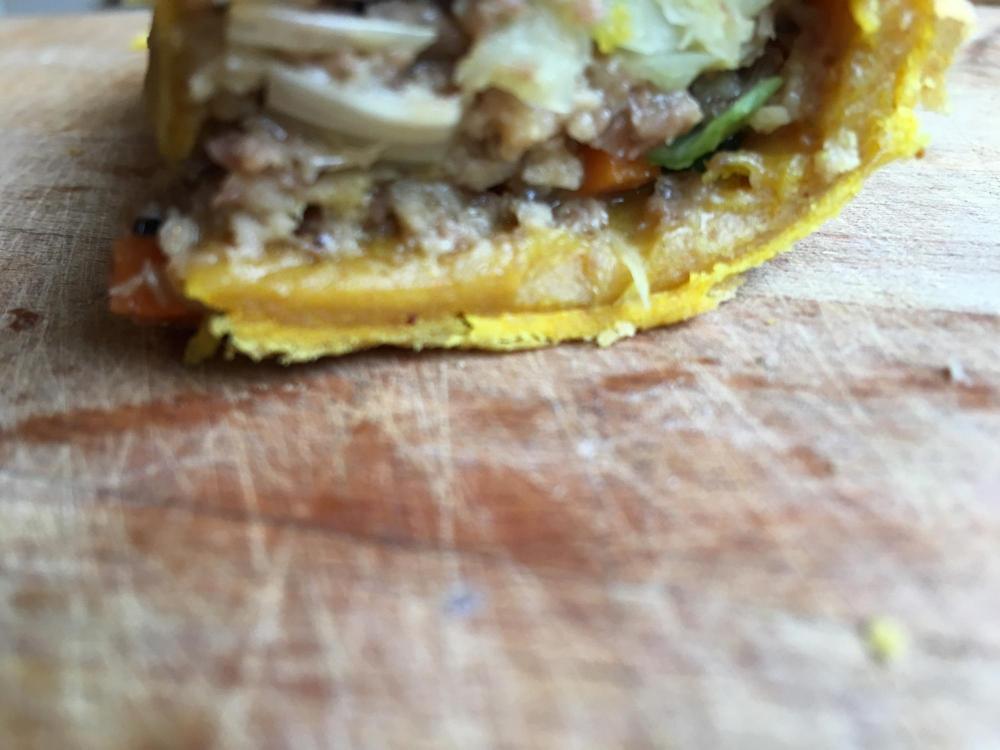
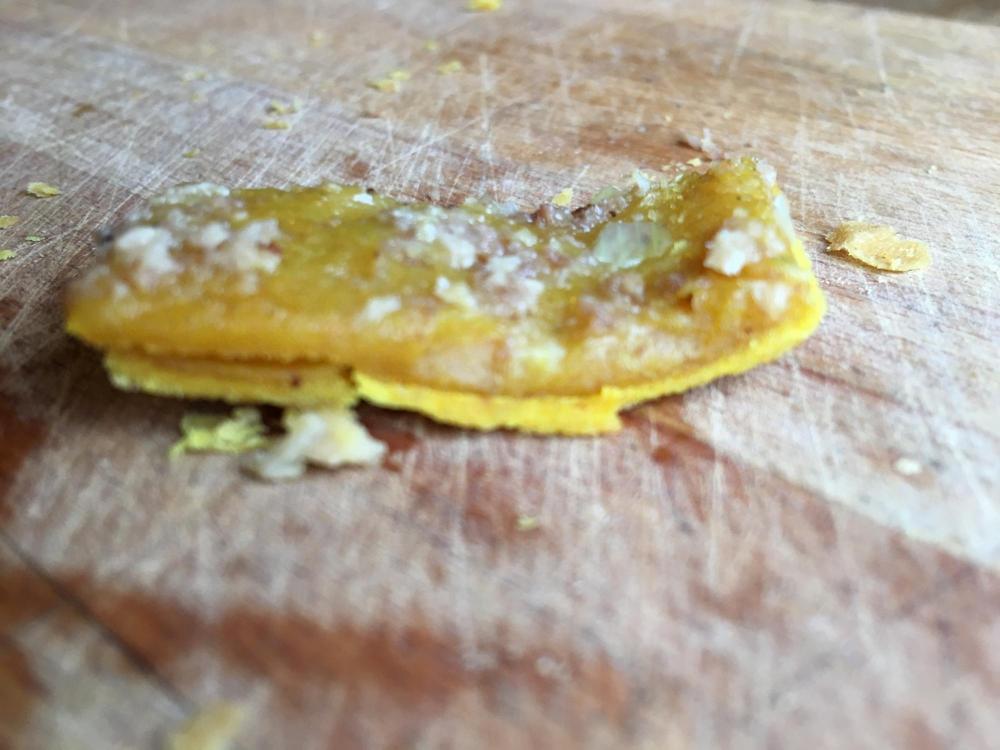
KFC's 11 not-so-secret herbs and spices
in Cooking
Posted
Yes. That'd be good. I've dabbled with: Dim Sims, Chiko Rolls, KFC O.R chicken, Violet Crumble/Crunch Bar/or chocolate coated honeycomb, then, Pancake Parlour's Tabriz Pancakes, variations on the Waldorf Salad, and developed a love-hate relationship with sauce thickeners and their post-frozen functionality. Most of these are still works in progress. I am growing my hair again so that I can pull it out in frustration again...